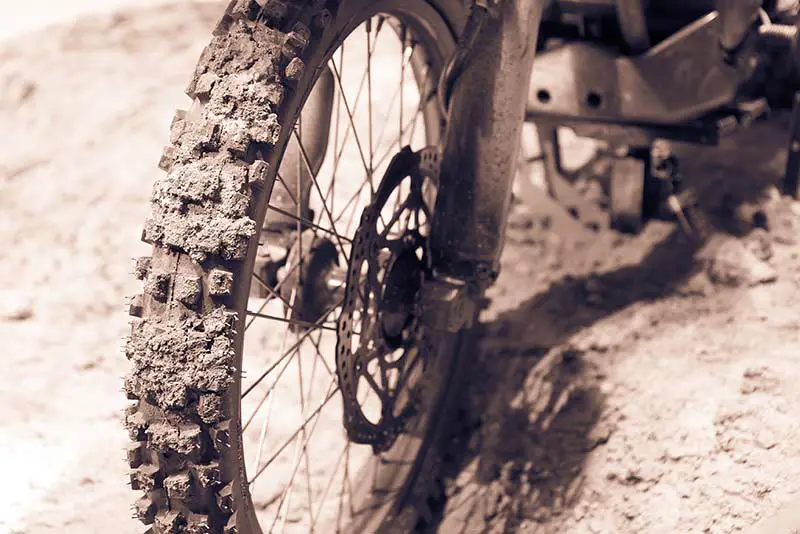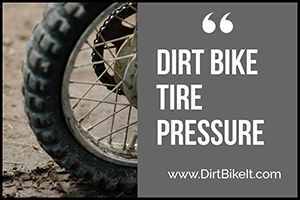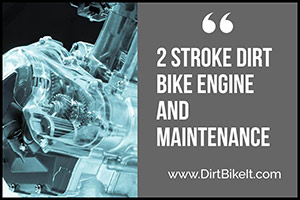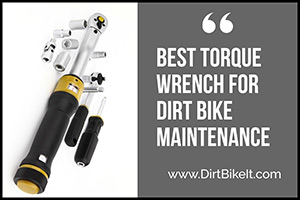Dirt Bike Tire Pressure PSI What’s Recommended

Dirt Bike Tire Pressure PSI Important or Not?
Motocross teams are constantly testing and tweaking their vehicles, striving to gain even the slightest of edges over their competitors. This testing and tweaking ranges from minuscule adjustments on their clickers to chain tension. They do whatever is in their power to create a faster and smoother bike, keeping their riders in the lead during races. An adjustment commonly glossed over by team mechanics is tire pressure, also known as psi (pounds per square inch). This adjustment can turn out to be crucial.
It is possible, of course, to ride on dirt bike tires which feel sufficiently good. However, riding with the right inflation in your tires is a completely different experience. The right inflation depends on the kind of terrain that you will be riding on. It is astonishing what a vast difference this factor can make to your riding experience. Tire pressure is very different in cars and bikes. In cars, a pound here or there doesn’t really have a big impact; but in dirt bikes it can be hugely influential. The right tire pressure gives you the ability to leave your friends far behind in the course of a ride or a race.
There is a lot of confusion over what the right tire pressure is when it comes to dirt bikes, and that’s no surprise: it is a confusing issue. Many dirt bike riders prefer not to get into the nitty gritty, opting for the usual 12 psi in the front and 12 psi in the back. Some riders add an extra half a pound to the back. However, this doesn’t take terrain into account. Riding off-road, for instance, requires higher tire pressure as compared to riding in sandy conditions, on a soft terrain. Dune riding, likewise, requires even lower tire pressure.
Another factor that riders need to take into account when determining tire pressure is the weather, with tire pressure increasing when the tire becomes hot. As a general rule, on fair weather days there won’t be a notable increase in the tire pressure as a result of riding. But on a hot day, say a 100-degrees, the tire pressure could be impacted by a few pounds. Since it takes very little time for a tire to heat up, it will only take a few laps for you to know how the weather is impacting the tire pressure overall. Altitude will also impact tire pressure. Be sure to check the tire pressure right before you start riding, and then again 30 minutes after you have been riding.
The best motocross teams give importance to even the slightest changes in psi, making adjustments of as little as a quarter of a pound. This is a good index of how important tire pressure is.
Always check tire pressure once you have reached your destination as opposed to checking it the night before when you’re at home. The reason for this is that elevation changes cause changes in tire pressure.
Ideal PSI for Trail or Track Conditions
If you’re riding off-road or on a track, you will want to begin with 12 psi in the front tire and 12.5-13 in the back tire.
When it comes to off-road, higher tire pressure is geared towards preventing flats rather than increasing speed, harder tires being one solid defense against getting flats, softer tires being easily punctured. By employing a Bib-Mouse, you can save yourself having to guess the ideal tire pressure. It supplies a consistent psi of 13 and removes the requirement for air. The disadvantage of a Bib-Mousse is that it is difficult to install and can only be used by Michelin Tires. If Michelin isn’t your brand, use a heavy-duty tube.
A psi of 12 is the ideal psi to start with when it comes to motocross tracks. Once you have a better assessment of the terrain, and you know whether you will be riding in blue groove or sand, you can adjust the tire pressure accordingly before you set off riding. Determining these factors is what you use a walk through and practice ride for. Most motocross tracks publish the riding conditions typically expected and can be a good source to decide your ideal tire pressure.
On sandy tracks, you need lower tire pressure. You can reduce your front tire psi to 11 and rear tire psi to 11.5. However, if you’re riding on hard pack, you want 13 psi font and 13.5 psi for the back. Also take the weather into consideration. If it’s hot outside, the tire pressure will increase as the tires become hot.
How to Prevent Punctures
Tire pressure is closely related to how often the tires on your bike get punctured. As a general rule, higher pressure helps in the prevention of flats, making the tire compress less upon impact with hard objects, making it likelier that the hard objects will simply bounce off. However, if the tire pressure is too high, that can create problems of other kinds.
TUbliss offers another option when it comes to the prevention of punctures. It involves the insertion of a small tube within the rim, that is set to very high psi, preventing the rims from getting damaged, attaching the tire strongly to the rim.
A mousse provides a third alternative for the prevention of flats. Mousses are cheap, making it impossible for any type of flat to occur. Their downside is that they are extremely heavy, and also they last for only 6 months.
Individuality
As is the case with other things in life, no two dirt bike riders are the same. There is a touch of individuality involved with everything. Ricky Carmichael, for instance, is famous for having ridden with the bars almost nestled in his lap. It is conceivable that you might be comfortable riding with 8 psi tires. At the end of the day it’s a question of what you’re comfortable with. But do bear in mind that if your back tire has a tendency to break loose of the front tire doesn’t remain planted when you turn corners, it just might point to an issue with tire pressure, provided that there is no problem with the other mechanics of your bike.
Even a Single Pound Can Make a Difference
A single pound worth of change when it comes to tire pressure results in nearly a 10% adjustment. It causes a change in the knob footprint, casing stiffness and overall traction, a change that can be exponential. When you’re dealing with tire pressure you’re dealing with a very sensitive issue, an issue that factories manage by as little as quarter-pound adjustments. So, when you’re adjusting the psi, adhere to increasing or decreasing it by a single psi. From there, you can fine tune it further in ½ or even ¼ psi increments.
Susceptibility to Flattening
The front tire of your dirt bike is more susceptible to being flattened. It possesses a cavity that is smaller, therefore less in air volume. If the tire pressure is the same for front and back tires, the impact required to flatten the front tire is significantly less.
How to Tell if the Tire Pressure is Too Great
The signs of excessive tire pressure are that there will be excessive wheelspin and a lack of grip. Additionally, there will be the absence of ‘rim clean.’
The General Rule of Tire Pressure
As a general rule, the tire pressure when it comes to dirt bikes can be anywhere between 6psi and 18psi as far as traditional tires are concerned. The commonest tire pressure recommended by passionate dirt bike riders is 12psi. If you consider yourself an average dirt bike rider with a bike that is average, riding on a terrain that is average, we recommend that you set 12psi as your tire pressure and forget about getting into the intricacies of tire pressure. If not, then it is important that you be aware of the exceptions of the 12psi guideline. It is not applicable to all circumstances. There is a lot of nuance that goes into choosing the right tire pressure for your bike.
Higher Tire Pressure: the Benefits
There are a few benefits that accrue from high tire pressure. The first of these is that it increases your speed, provided all else remains equal. Secondly, high tire pressure gives protection to the rim and the tire, protection from impact on solid object such as rocks. This is particularly useful if you’re riding on rough terrain, with plenty of sharp rocks and tree roots on it. If this is the kind of terrain that you will be riding on, you should consider increasing your tire pressure up to 15 psi. Higher tire pressure is also beneficial for riders who are heavier, requiring greater cushion.
Lower Tire Pressure: the Benefits
The first benefit that lower tire pressure brings is that is offers better traction. This is particularly useful if you’re riding on official motocross tracks, tracks where you know that there aren’t any sharp objects like tree roots and boulders around. Lower tire pressure is also useful light weight riders, riders whose weight won’t press the tires down. It is also wonderful for loose terrains, including loose rock, mud and soft clay. You can drop the tire pressure down to around 9psi if you’re riding on terrain like sand.
Four Factors Impacting Tire Pressure
The first factor that impacts tire pressure is the tire type that is used. Secondly, the riders weight will have a bearing on it, heavier riders requiring high tire pressure, lighter riders requiring low tire pressure. Thirdly, the type of terrain will impact tire pressure, hard and rocky surfaces requiring high tire pressure and loose terrains like mud requiring low tire pressure. Fourthly, and lastly, the kind of protection that the rider prefers to use on his/her tires will have an impact on tire pressure. Low tire pressure will create greater traction but can easily damage the rims.
Tire Pressure for 4-Stroke Bikes
The weight transfer on 4-stroke bikes is different from what it is on 2-stroke bikes. 4-strokes have a tendency to smash through obstacles rather than skimming over them, a characteristic that puts greater load upon the front tire as compared to the back tire. While the typical tire pressure for the front wheel on 2-strokes is 12psi, on 4-strokes it should be increased to 14psi. The back tire can remain at 12psi.
Things to Watch out for
If your tire pressure should drop too low in the course of a ride, there will be several things to alert you to the fact, signifying that it is time to increase the tire pressure. One such sign is that you will feel as though the bike doesn’t corner tightly; this is caused by the tire roll. You may also experience a loose kind of wobble in your tires when you’re riding and medium speeds. These are signs that your tire pressure is too low. Another such sign is if the rims start getting dinged up or bent. Prior to this you will, in all likelihood, experience it while riding and the rims get hit hard.
In case the tire pressure is excessively high, you might notice that the tire loses grip when riding on loose terrain. Additionally, the tires will spin more than they ought to.
One other way of gauging the right tire pressure is by observing the ‘rim clean.’ Where the rim meets the tire, you can observe a small shinier ring all around its edge. That shiny area belongs the part where the tire has been rubbing upon the rim. That is referred to as the rim clean. The majority of riders recommend that the shiny area, the rim clean, ought to be 3-4mm, indicating that the tire pressure is ideal. Should the rim clean be too big, it indicates low tire pressure, tire pressure that needs to be increased. If it is too small, it indicates excessively high tire pressure, tire pressure that needs to be decreased.
Get a Good Quality Tire Pressure Gauge and Pump
In order to get the correct tire pressure reading, you have to use a quality gauge. I highly recommend you just get PressCheck Air Iire Pressure Gauge. It is fairly inexpensive and meant for dirt bikes.


